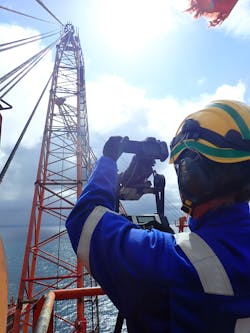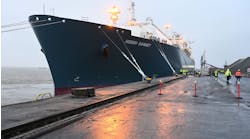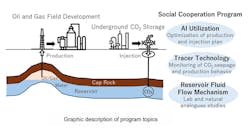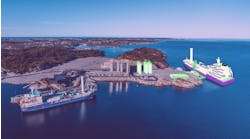Visualization software helps deliver quicker inspection results
The demanding economic climate of the oil and gas sector, particularly with the impact of COVID-19, has conspired to accelerate the demand for and implementation of smarter working methods. Within this context, the value potential of digital technologies is being more widely adopted to allow existing operations to continue safely and sustainably, for a better future.
The Arup Integrity Management software application was originally used on major infrastructure projects and was subsequently repositioned to digitize the entire inspection workflow by leveraging automation, overhauling the current paper-based and outdated manual process.
The digital inspection technology enables secure, cloud-based real-time data access for engineers and managers, to drive better operational decision-making. Arup’s technology utilizes 3D modelling to visually represent risks and anomalies but is unlike other applications in that it is not constrained to recording only visual data. It can therefore offer the complete picture across all inspection types as well as being adaptable to future sources of data. Examples of the data sources that are aggregated include remote visual inspection by computational photography, drones, traditional and advanced non-destructive testing and outputs from other analytical processes allied with automated report generation.
By channeling multiple data sources in an accessible visual format, the technology brings together the whole system including operator, engineer and inspection contractor so that teams can successfully understand the state of the asset including the condition of the process safety barriers and can work collaboratively.
Arup, a global engineering and consultancy firm, and MInteg, EnerMech’s specialist integrity and inspection team, shared a vision to provide a solution that enables management to harness the true value from increasing amounts of data and where possible to automate the capture of that data and the workflow processes to reporting.
In 2019, MInteg and Arup formed a strategic partnership. Working collectively on a shared challenge, Arup Inspect MInteg (AIM) was conceived, offering Arup’s technology and MInteg’s inspection expertise as an enhanced inspection service to the oil and gas industry. The tablet-based AIM application is a core part of the digitally enabled inspection service, with the goal of enhancing and revolutionizing the inspection process for the oil and gas industry.
When compared with traditional inspection service models, the application has been proven to generate 30% cost savings in the activity of visual inspection.
The novel visualization software uses technology from the gaming industry to enable operators to deploy smaller, more agile inspection teams, thereby delivering quicker inspection results directly into the 3D model-based tablet application. The application allows clients to access this high-quality, centralized inspection data for enhanced decision-making.
A fundamental element of a smooth gaming experience is interacting with gamers across the globe, minimizing bandwidth demands and optimizing the experience both visually and functionally. AIM achieves this by ingesting a client’s existing 3D computer-aided design (CAD) models, point clouds, or 360-degree photographs. The ability to use existing 3D assets makes the overhead of delivering AIM as low as possible.
If a client does not hold 3D asset data, this can be created. For example, automation workflows are used to translate existing structural analysis geometry models to AIM compliant formats, or experienced CAD designers can create the 3D assets required. MInteg and Arup’s approach to visualization is based on considering the level of detail required to be fit for the purpose.
By focusing on the value associated with this data, AIM uses 3D models or point clouds to present an impactful visual representation of diverse inspection data, allowing the user to filter the important information, to optimize plans and make timely and improved decisions based on an improved understanding of how this contributes to cumulative risk. The user is given the information that they need in the context of the facility or the asset they are responsible for, driving action and collaboration for better planning and scheduling. For MInteg, as contactor responsible for inspection, it transforms service quality both in cost and value as well as communication to clients.
AIM can also incorporate machine learning and artificial intelligence technology to automate processes such as corrosion identification, removing the need for human interaction with repetitive data sets where consistent assignment of qualitative severity categories becomes difficult across large datasets.
The technology can play a major role in rapidly achieving savings at scale and has been successfully used by production managers and operational teams to understand the state of their asset and the condition of the process safety barriers. The application is currently being deployed by operator Apache on the Beryl Alpha platform in the North Sea to improve safety and reduce risk and asset inspection costs.
The technology is being augmented by high-resolution 360-degree photography, substantially eliminating the need for high-risk rope access work. Over 60,000 images were captured on the recent Apache project. Using the application, the data is managed effectively, and specific data can be recovered efficiently and easily for fast assessment.
Through enhanced quality and availability of inspection data, the application has contributed to improved reporting and day-to-day communications, leading to more informed decisions on asset repair, replacements and improvements. As a result, the total cost of inspection was reduced by 20% and reporting time decreased by 25%.
AIM has already been adapted from one industry for use in another, and the technology has the potential to be further adapted to revolutionize asset operations in industries such as renewables, and the wider energy transition landscape globally.
The use of integrated and intelligent ways of working and transitioning from traditional approaches to solving client problems will be vital for all suppliers to survive and thrive, and for the best long-term prospects for the sector.



